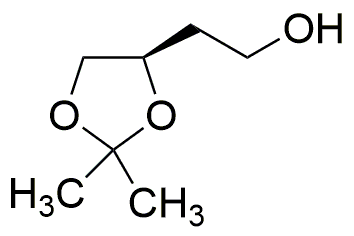(R)-4-(2-Hydroxyethyl)-2,2-dimethyl-1,3-dioxolane is widely utilized in research focused on:
- Pharmaceutical Development: This compound serves as an important intermediate in the synthesis of various pharmaceuticals, enhancing the efficacy and stability of active ingredients.
- Cosmetic Formulations: Its unique properties make it a valuable ingredient in skincare products, providing moisturizing benefits and improving the texture of creams and lotions.
- Polymer Chemistry: Used in the production of specialty polymers, it contributes to materials with enhanced durability and flexibility, ideal for applications in packaging and coatings.
- Flavor and Fragrance Industry: This chemical is utilized in creating flavoring agents and fragrances, offering a pleasant scent profile that can enhance consumer products.
- Research Applications: In academic and industrial research, it is employed as a reagent for various chemical reactions, aiding in the development of new compounds and materials.
General Information
Properties
Safety and Regulations
Applications
(R)-4-(2-Hydroxyethyl)-2,2-dimethyl-1,3-dioxolane is widely utilized in research focused on:
- Pharmaceutical Development: This compound serves as an important intermediate in the synthesis of various pharmaceuticals, enhancing the efficacy and stability of active ingredients.
- Cosmetic Formulations: Its unique properties make it a valuable ingredient in skincare products, providing moisturizing benefits and improving the texture of creams and lotions.
- Polymer Chemistry: Used in the production of specialty polymers, it contributes to materials with enhanced durability and flexibility, ideal for applications in packaging and coatings.
- Flavor and Fragrance Industry: This chemical is utilized in creating flavoring agents and fragrances, offering a pleasant scent profile that can enhance consumer products.
- Research Applications: In academic and industrial research, it is employed as a reagent for various chemical reactions, aiding in the development of new compounds and materials.
Documents
Safety Data Sheets (SDS)
The SDS provides comprehensive safety information on handling, storage, and disposal of the product.
Product Specification (PS)
The PS provides a comprehensive breakdown of the product’s properties, including chemical composition, physical state, purity, and storage requirements. It also details acceptable quality ranges and the product's intended applications.
Certificates of Analysis (COA)
Search for Certificates of Analysis (COA) by entering the products Lot Number. Lot and Batch Numbers can be found on a product’s label following the words ‘Lot’ or ‘Batch’.
*Catalog Number
*Lot Number
Certificates Of Origin (COO)
This COO confirms the country where the product was manufactured, and also details the materials and components used in it and whether it is derived from natural, synthetic, or other specific sources. This certificate may be required for customs, trade, and regulatory compliance.
*Catalog Number
*Lot Number
Safety Data Sheets (SDS)
The SDS provides comprehensive safety information on handling, storage, and disposal of the product.
DownloadProduct Specification (PS)
The PS provides a comprehensive breakdown of the product’s properties, including chemical composition, physical state, purity, and storage requirements. It also details acceptable quality ranges and the product's intended applications.
DownloadCertificates of Analysis (COA)
Search for Certificates of Analysis (COA) by entering the products Lot Number. Lot and Batch Numbers can be found on a product’s label following the words ‘Lot’ or ‘Batch’.
*Catalog Number
*Lot Number
Certificates Of Origin (COO)
This COO confirms the country where the product was manufactured, and also details the materials and components used in it and whether it is derived from natural, synthetic, or other specific sources. This certificate may be required for customs, trade, and regulatory compliance.


